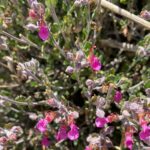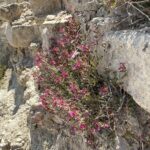Τεύκριο το απλωμένο υποείδος το γκριζοασπρότριχο
Etymology of divaricatum subsp. canescens: The Ancient Greek name "Teucrium" [Τεύκριον] was used by Dioscorides for several species in this genus and is assumed to refer to King Teucer [Τεῦκρος] of Troy who used the plant in his medicine; assumed, because there was also another famous Teucer, son of King Telamon of the Island of Salamis, today in Greece. Teucer was a great archer who fought alongside his half-brother, Ajax, in the Trojan War and is the legendary founder of the ancient city of Salamis in Cyprus. "Divaricatum" is Latin and means "wide-spreading/spread out". "Canescens" is also Latin and means "having a fine grayish-white pubescence".
At least 10 kinds of Teucrium plants (species and subspecies) have been discovered in the Cypriot habitat so far, of which three of them appear exclusively in occupied Cyprus north.
Teucrium divaricatum subsp. canescens is an indigenous and endemic plant in Cyprus. Even though it's an uncommon plant to see, it exists in many parts of Cyprus except for the Akamas region and the Central Mesaoria region (Nicosia and surrounding areas). Teucrium divaricatum subsp. canescens grows up to an altitude of 1675 metres. The solitary plant in the picture was photographed in Agios Therapon (Limassol district) on almost vertical limestone ground. Its flowering period is between May and July.




